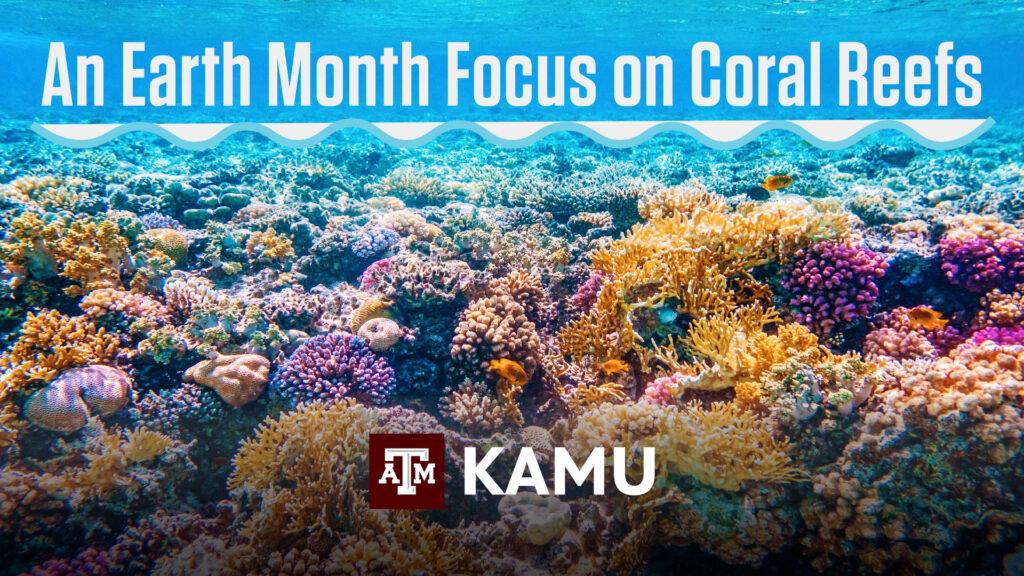When you think of Earth Month, you may think of recycling and taking care of the environment. But don’t forget our oceans!
71% of our ever-changing planet is the ocean. Full of some of the most diverse species in the world, our oceans are something that we should protect. This includes the vibrant, beautiful living structures that are coral reefs.
A new “Changing Planet” special highlights the many challenges that coral reefs face. From bacterial diseases to ocean warming, the health of these organisms is at stake. In this episode, visit coral reefs in the Maldives to learn from the researchers and scientists fighting to keep the species alive.
You can celebrate Earth Month and learn more about the many ways you can help save coral reefs by tuning in to “Changing Planet” on Wednesday, April 24 at 7 p.m. Watch the trailer here.
In anticipation of the show, KAMU spoke with Texas A&M oceanography professor Dr. Katie Shamberger about her experience researching coral reefs.
Fascination with the Ocean
“The whole reason I went into oceanography was because I grew up near the coast in southern California,” Shamberger said. “I was just obsessed with the beach and the ocean and all I ever wanted to do was study it.”
Although she works under the large umbrella of oceanography, her research specialization is in chemical oceanography, or the study of seawater chemistry, including carbon dioxide in the ocean and ocean acidification.
“Humans are burning lots of fossil fuels – oil, coal and gas – to produce the energy we need to run our society,” Shamberger said. “This puts a lot of carbon dioxide into the atmosphere and it mixes into the surface of the ocean. The water kind of sinks and brings that CO2 into the interior of the ocean, causing a reaction that produces carbonic acid.”
Shamberger says this carbonic acid leads to ocean acidification – the “lowering of the pH of the ocean.”
What is Ocean Acidification?
Since the 1980s, ocean acidity has increased by 30%. This fluctuation over just a few decades “occurred at a rate 100 times faster than any change in acidity experienced during the last 55 million years,” according to the European Environment Agency.
“Coral reefs are one of the organisms that are really sensitive to ocean acidification,” Shamberger said. “This makes it harder for corals to build their skeletons. It enhances erosion, dissolution and basically breaks down the reef’s structure.”
The reefs’ failure to build these skeletons not only weakens their own systems but also takes away the habitats of other sea life.
“The skeleton that accumulates and makes the big three-dimensional reef structure has lots of hiding places and areas for other organisms to live,” Shamberger said. “It’s part of the reason why coral reefs are one of the most diverse ecosystems on the planet.”
Ocean acidification, along with ocean warming, are considered global stressors for coral reefs. Dr. Shamberger defines these as negative impacts that reefs all over the world are experiencing, not just those in one particular area.
Local vs. Global Stressors
Shamberger says there are also local stressors, which are negative impacts “that are happening on an individual or regional basis.” The amount of reefs that experience these stressors varies worldwide
“The really common ones are any sort of pollution from land,” Shamberger said. “It could be like sedimentation coming off the land and covering up the corals or it could be actual chemicals coming off the land.”
At least 75% of reefs in the Atlantic and over 65% of reefs in the Middle East experience at least one local stressor, according to the Reef Resilience Network.

Another local stressor that heavily impacts the health and well-being of coral reefs is overfishing.
“It can really damage coral reefs and throw off the food webs if you pull out too many of the delicious fish that live in and around the organism,” Shamberger said.
For more information visit the Reef Resilience Network website.
The severity between local and global stressors varies as well as the ability to stop the effects they have on reefs.
“Local stressors are generally easier to control,” Shamberger said. “You can make laws locally and can get communities to clean up and preserve their coral reefs because they usually depend on them in some way.”
What Can Humans Do?
Shamberger says by fixing local stressors, reefs will have a better chance of surviving global stressors, which are much harder to solve.
“Climate change, ocean acidification and ocean warming are global problems that nations all over the world need to agree about,” Shamberger said.
Reducing these negative effects on coral reefs is a team effort that only requires simple lifestyle changes.
“Anything you can do to reduce your energy usage is worth doing,” Shamberger said. “Even super simple things like not leaving my laptop on the charger all day.”
If anyone can do it then our Aggies definitely can!
“If you think about just one person making those changes it’s not that big of a deal,” Shamberger said. “But if you think of 70,000 students at A&M doing little things to reduce their energy usage it actually adds up to a lot of carbon dioxide not being put into the atmosphere.”
You can learn more about Dr. Shamberger’s research here.
Be sure to tune in to “Changing Planet” on Wednesday, April 24 at 7 p.m. You can also stream the special for free on PBS.org for 30 days after its premiere. Afterwards, it will be available on PBS Passport.






